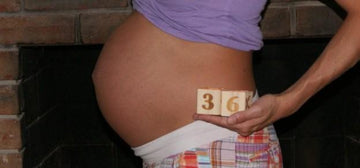What is Meconium Stained Amniotic Fluid – Is it Normal?

Current research disproves the need of immediate alarm that occurs when meconium is found in the amniotic fluid.
Meconium staining may not only be ‘not scary’ for almost every birth, but it is actually quite normal for babies born between 37-42 weeks gestation!
Meconium is the name given to the first poop a baby has. It is 70-80% water and a combination of everything your baby has ingested while in utero: mucus, amniotic fluid, intestinal epithelial cells, and lanugo (the little hairs that cover baby in the womb). It is, thankfully, odorless, but quite hard to wipe clean. It generally takes about 3 days to clear the newborn’s system, and then the “mustard seed” poop arrives. Approximately 15-20% of all babies will have meconium present when water breaks in labor.
Why is there poop in my baby's fluids?
 There are three theories as to why the baby passes meconium before being born: Source
There are three theories as to why the baby passes meconium before being born: Source
- The digestive system has reached maturity and the intestine has begun working. A working intestine allows meconium to pass. This is believed to be the most common reason, as 15-20% of babies passed 37 weeks and 30-40% of babies born passed 40 weeks will have passed meconium in-utero.
- During labor, the cord or head can be compressed (especially during second stage- pushing, which is the most common time for the bag of waters to break). This is the same reflex that causes variable heart rate decelerations, which are a normal physiological response and can happen without fetal distress.
- True fetal distress resulting in hypoxia. This has been disproven through research because hypoxia occurs without meconium being present, but the theory is that lack of oxygen relaxes the anal sphincter and allows meconium to pass.
- Most babies who are born in a poor condition do not have meconium stained amniotic fluid
- Most babies with meconium stained fluids are born in good condition
“During labor and birth it is very unlikely that a baby will inhale liquor (and any meconium in it). This will only happen if the baby becomes extremely hypoxic and begins to gasp in utero in an attempt to get oxygen. So, meconium alone is not a problem. Meconium + a hypoxic baby = the possibility of MAS (Davies & MacDonald 2008).”
An abnormal heart rate predicts fetal distress much more accurately than MSAF (Meconium Stained Amniotic Fluid); and an abnormal heart rate along with meconium in the water may be an even better indication that a baby may be in trouble. In addition, thick meconium rather than thin meconium is associated with complications in these conditions. (Source).
Meconium Aspiration Syndrome (MAS)
Having meconium in your amniotic fluid gives your baby a 0.06% (1:1667) chance of dying from MAS. This risk will go up and down slightly depending on each mother’s circumstances. Risk factors for increasing the chance of baby inhaling meconium (remember, the presence of meconium is not only normal, but safe.):- Prematurity
- Induced Labor
- Pitocin Use
- Labor Complications
- Traumatic Birth
- Cesarean Section
- Bluish skin color (cyanosis) in the infant
- Difficulty breathing (the infant needs to work hard to breathe)
- No breathing
- Rapid breathing
- Limpness in infant at birth
If Meconium is Present
Do not panic. Talk to your birth team and make sure to be looking for any signs of fetal distress. Meconium staining alone is NOT a reason to intervene with the labor. Do not rush the birth. the more easy and natural the birth, and the more time the meconium has had to mix and circulate with the fluids present in baby‘s environment, the less of a threat meconium poses. Aspiration becomes less likely. Do not be talked into a c-section. Source
'As a result (of MSAF) doctors usually perform caesarean delivery within the next few hours. The unfortunate part of this is that the vast majority of these deliveries will result in a worse outcome for both mother and baby then if a vaginal delivery of the baby had been allowed under attentive supervision and care.’
After Birth Care for MSAF
From the peer-reviewed AIMS Journal : “Suctioning of the healthy baby's airways at birth is no longer recommended; this is advised only if the baby has thick or tenacious meconium present in the mouth and/or nose. For home birth the midwife carries equipment for the rare occasion when the baby needs resuscitation. Leaving the umbilical cord intact until it has ceased pulsating will help the baby gradually adapt to extrauterine life and ensure it has optimum blood volume for full lung expansion. The baby should be kept warm by close skin-to-skin contact with the mother; early nuzzling and suckling will help the baby absorb any mucus and liquid left in its lungs. NICE guidelines advise that where there has been significant meconium staining, the baby should be closely observed at one and two hours of age and then two-hourly until 12 hours of age. Following a home birth the midwife will normally stay for at least the first two hours or until she is satisfied that all is well with mother and baby. On leaving, she should ensure the parents know how to recognize any problems, and who to contact if they have any concerns. Well-informed parents are invariably the most diligent observers of the wellbeing of their own baby.”







